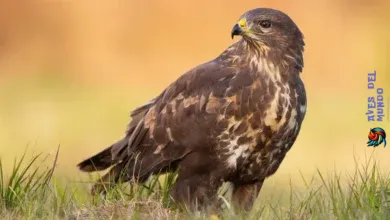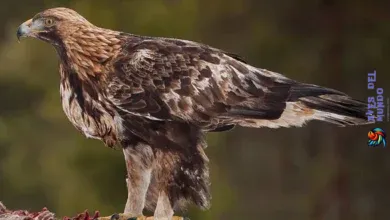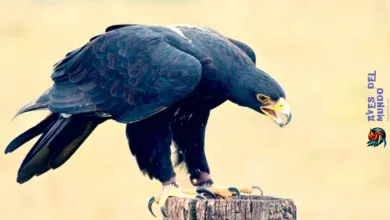Characteristics Golden Eagle-Aquila chrysaetos
Characteristics
Activity: Daytime
Weight approx. male: 3.7 kg
Weight approx. female: 6 kg
Wingspan: 180 – 234 cm
Food: Small and medium-sized mammals, birds, some reptiles and carrion
Threats: Humans, poison, electricity pylons and crows.
Conservation status: Least concern.
Area of distribution:

State of conservation: Minor concern.


Distinguish from other species
Size easily distinguishes this species from most other birds of prey when viewed well. Most other birds of prey are considerably smaller. Buteo falcons, which are perhaps most similar to the golden eagle in structure among species outside the «booted eagle» group, are often among the largest and most common birds of prey. However, a medium-sized Buteo is dwarfed by a golden eagle, as an adult female has about twice the wingspan and about five times the weight. Buteos also tend to be distinctly paler on the underside, although some species occur in dark forms that may be darker than a golden eagle.
Among birds of prey that share the golden eagle’s range, only some Old World vultures and the California condor are distinctly larger, with longer, broader wings, typically held more evenly in slower, less flight. overwhelming; They often have dramatically different color patterns. In North America, the golden eagle can be confused with the vulture from a distance, as it is a large species that, like the golden eagle, usually flies with a pronounced dihedral. The vulture can be distinguished by its less controlled and forceful flying style (they frequently rock back and forth unsteadily even in moderate winds) and its smaller, thinner body, much smaller head, and, at greater distances, , its blackish brown color and silver wing secondaries.
Compared to Haliaeetus eagles, the golden eagle has wings that are only slightly thinner but more hawk-like and lack the flat, plank-shaped wing position seen in the other genus. Large northern Haliaeetus species typically have a larger beak and a larger head that sticks out more clearly than that of a golden eagle in flight. The tail of the golden eagle is on average longer than that of Haliaeetus eagles, appearing two or three times the length of the head in high flight, while in other eagles the head is usually more than twice the length of the tail.
There is most likely confusion between juvenile Haliaeetus and golden eagles, as the adult gilthead has a more solid golden-brown coloration and all Haliaeetus eagles have obvious distinctive plumages as adults. Haliaeetus eagles usually have many stripes in their juvenile phase. Juvenile golden eagles may have large white spots on their wings and tail that are quite different from the random, sometimes large, spotted-looking white distribution typical of juvenile Haliaeetus.
Distinguishing the golden eagle from other Aquila eagles in Eurasia is more difficult. Identification may depend on the golden eagle’s relatively long tail and the white or gray patterns on the wings and tail. Unlike golden eagles, other Aquila eagles generally do not fly in a steep dihedral. Up close, the golden to rufous nape shawl of the golden eagle is distinguished from other Aquilas.
Most other Aquila eagles have darker plumage, although the smaller tawny eagle is usually paler than the golden eagle (range overlap occurs only in the Bale Mountains, Ethiopia). Among the Eurasian Aquila, the adult eastern imperial eagle and the Spanish imperial eagle are closest in size to golden eagles, but both are distinguished by their longer necks, flatter wings in flight, white markings on the coverts of the forewings of the shoulders and a paler straw-cream color. patch on the nape of the neck and generally darker coloring.
Juvenile imperial eagles are much paler overall (caramel cream in Spanish; cream and tawny streaks in eastern ones) and are not likely to be confused. Steppe eagles may also approach golden eagles in size, but are more compact and smaller-headed, with little color variation in their dark earth-brown plumage, apart from juvenile birds that have distinctive cream-colored bands running down their backs. coverts and secondaries.
Verreaux’s eagles are more similar in size and body shape to golden eagles, with the body of the Verreaux’s eagle being slightly longer overall, but marginally less heavy and long-winged than that of the golden eagle. However, the plumage is very different, as Verreaux’s eagles are almost entirely jet black, except for striking contrasting white on the primary wings, shoulders, and upper wing.
This closely related species is known to coexist with the golden eagle only in the Bale Mountains of Ethiopia. Other booted eagles in the golden eagle’s range are unlikely to be confused due to differences in size and shape. The only species in the genus Aquila that surpasses the golden eagle in average wingspan and length is the Australasian wedge-tailed eagle; However, the wedge-tailed eagle is a slightly less heavy bird.



